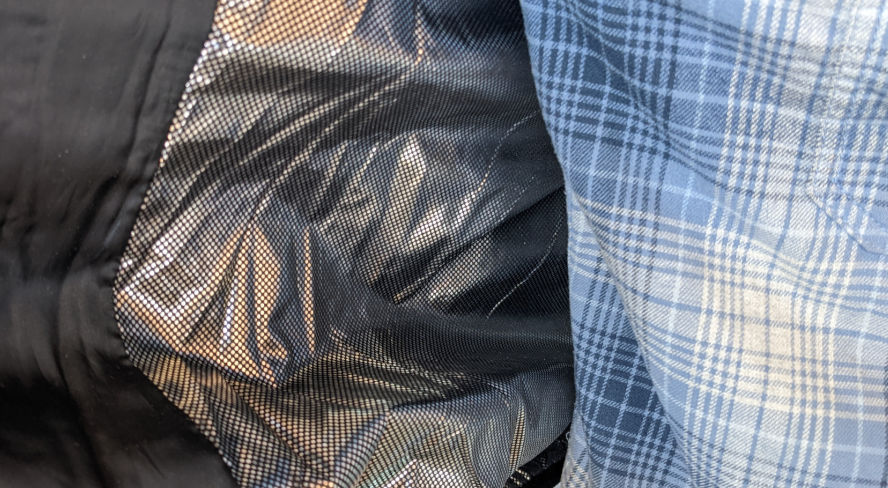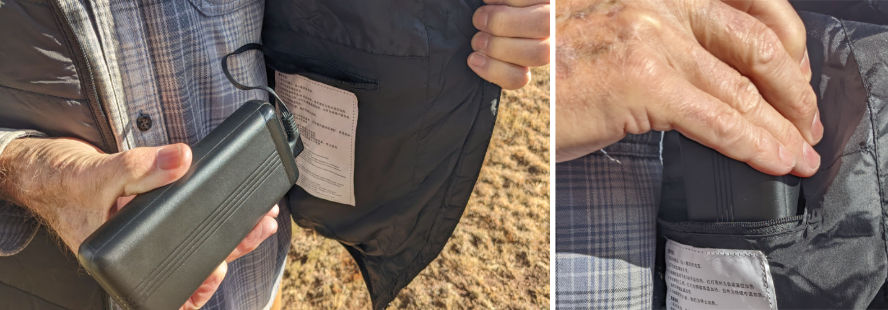ONE CHILLY DAY an ad for an electric heated vest came up on my Facebook feed. I knew such a thing existed but had never experienced one. Since I’ve been writing articles about ways to keep warm I figured I’d order one to test.
The seller was one of those companies that promotes the same product under different names — a name I never bothered to remember even though they kept sending me order tracking updates every time it changed hands, from China to Finland to Italy to Miami… Sort of the long way around the world for me, but it eventually arrived. Just as the chilly weather turned cold.

It’s a vest, alright
There’s nothing odd looking about the vest. It’s your basic black, lightly quilted, nylon vest. And although the sizing on some Asian-sourced garments runs small (or we North Americans run big) the vest fit correctly.

The back of the vest is lined with a silvery material. I don’t know whether it’s to aid transfer of heat to your body, or to hold body heat in, or to protect your clothing from scorching. There was nothing about it in the enclosed literature because there was no enclosed literature. The only instructions were on a large label inside the vest. And there is no brand anywhere on the garment.

The heating elements — located on the back, in the collar, and on the front — are powered by a 20,000 mAh lithium battery. It looks just like one of many marketed for keeping laptops, tablets and smartphones charged. So you could use it that way in the off seasons. There are two USB-A ports and two USB-C ports. It comes with a USB-C cable for charging but no AC adaptor. The battery connects to the vest via a USB-A cable inside a zippered inner pocket where you carry the battery.

Two rubber buttons on the left breast control the heating — one for the front, one for the back. You turn the vest on by holding the buttons down until they turn red, which is for the high heat setting. After a few minutes of heating, the vest automatically switches to the medium setting and the buttons turn white. The low heat setting is blue. You can cycle through the settings as you wish, and you can set the front and back at different levels from each other.

So, how warm does it get?
The big Goldilocks question was whether the vest would get warm enough or too hot. Would it shock me? Start a fire? Do nothing at all? Would it even work? The battery showed a partial charge, so I plugged it in, pushed the buttons on the chest, and waited.
I felt the heat on my neck first because it was bare. It was very nice, like a hot washcloth when I have a headache, only dry instead. It took a little longer to feel the warmth through my flannel shirt and t-shirt. It wasn’t overpowering, and I wouldn’t call it toasty. It was simply enough to warm me without feeling like I was going to break into a sweat. When it automatically dropped to the middle setting, there was still a hint it was at work, and when I switched it to the low setting, it felt like enough to maintain body temperature in the cold. Of course, that would depend on how cold it is.
A subfreezing night was at hand, so I decided to wear the vest to bed. That would also let me know how long the battery (now fully charged) would last. It wasn’t the most comfortable experience, with the battery poking me in the side if I moved the wrong way, but I was nice and warm. I eventually turned it to the low setting.
After a few hours I realized it was my feet that needed the heat, not my torso. So I removed the vest and spread it out at the bottom of the bed. That worked well.
The battery ran out sometime during the predawn hours. My guess is that you can run the vest for seven or eight hours on medium. If you need heat for longer than that, you could have an additional battery pack or two.
Care and feeding
The washing instructions on the lable say:
Take out power bank. Use gentle washing detergent, gentle hand wash, do not force knead or over agitate the garment. Air drying naturally is recommended.
The safety instructions say:
If not used for a long time, do not plug in power bank.
Do not use high temperature water or strong acid/corrosive detergent.
Strictly forbidden to use electricity on wet clothes. Please turn off the power and stop using the heating option if garment is wet.
Duration of heat in garment is dependent on the capacity of power bank.
Conclusions
I went into this expecting to be disappointed. (Is it disappointment if your expectation of disappointment is accurate? Or is that pleasant validation? Or are you disappointed if you were wrong about being disappointed?) The vest worked and it warmed me up. I’ve used it a few more times and it still works.
What’s the lifespan of this no-name vest? I don’t know. Is it worth the $79.90 I paid INCKWP, Co.,Ltd? Similar heated vests on Amazon go for $89 to $139, so there’s that. If I spent my time in regions that got seriously cold, one of these vests would certainly be worth eighty bucks or more to me. But even if the vest crapped out on me, I’d have a power bank to charge my stuff.

” (Is it disappointment if your expectation of disappointment is accurate? Or is that pleasant validation? Or are you disappointed if you were wrong about being disappointed?)”
Perfect for us who are working hard to change outlook from negative, cynical to positive up-beat! We can be wrong about expecting the worst!
There are battery heated socks that might disappoint too!
I bought a $50 batteryless vest for testing. Works very well but I am concerned about longer-term durability. For this reason I only use it when other more robust options are ruled out.
Mine runs at 5/7.5/10w averages on the three settings. Most of the time I’m using it at my “desk”, from a 12v->USB output.
AL, great info. I didn’t know those types of clothing existed; it would nicer yet to have a WHOLE quilted jacket with heat on, wouldn’t it ?? Thank you for the informative article. ?
Since the core releases more blood back to the extremities when core is warm, we have a situation where a simple, cheap solution works well. The more complex solution (collars, sleeves, whatever) does provide more even heat Downside is it tend to be ## and have more failure points where the resistance heating material bends.
When I rode motorcycles in cold weather I had heated vest, sleeves, pants, gloves, and soles. 70mph wind chill is a beast! Now that I follow mild weather in the van a vest is sufficient to my needs.
Milwaukee Heated Jackets , Awesome
Harold, great… thanks !!??
https://www.milwaukeetool.com/Products/Work-Gear/Heated-Gear
In Case your Wondering where to look Lucy .